![The Mohican Board! [Bumppo's Redux!] The Mohican Board! [Bumppo's Redux!]](images/wwwboard.gif) |
|
| Author |
 Topic Topic  |
|
|
James N.
Colonial Militia
   

USA

Bumppo's Patron since [at least]:
October 24 2007
Status: offline
|
 Posted - October 14 2012 : 2:44:11 PM Posted - October 14 2012 : 2:44:11 PM



|
Earlier this summer and quite apart from my visit to Gold Rush Country and Calaveras Big Trees State Park I made a quick trip to the Los Angeles area. Seeing the Giant Sequoyas near Murphys, California, fulfilled one lifetime dream; I took advantage of my stay here to accomplish another. I'd hesitated to post this, and when I did finally decide, questioned exactly WHERE it belonged: this isn't really a historic site, but rather prehistoric; and downtown L.A. is hardly "wilderness" anymore! But it once WAS, and somehow despite its current surroundings on Wilshire Boulevard amid tony boutiques and office buildings, it SEEMS to belong here!
Image Insert:
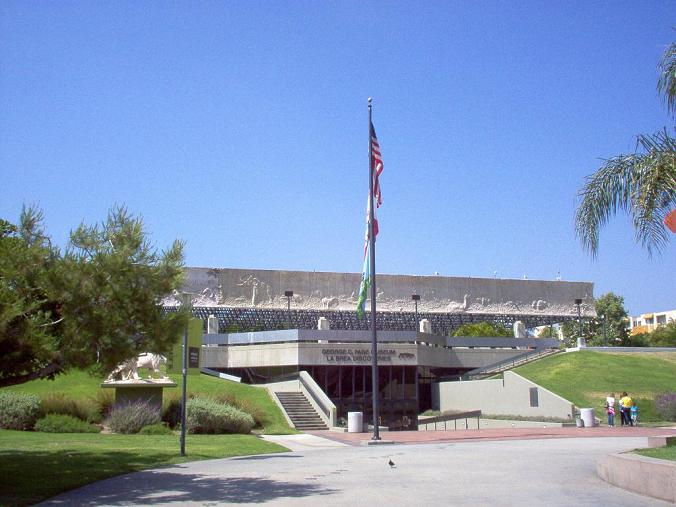
60.92 KB
The Page Museum displays artifacts removed from the "pits" made over the eons by the bubbling asphalt.
Originally Rancho La Brea ( la brea is TAR in Spanish ) was a Spanish land grant that featured odd bubbling pools/pits of asphalt ( "tar" ) that were observed to contain the bones of animals; it was thought these were deer, coyotes, wolves, and stray domestic cattle. Sometime around the turn-of-the-century it was noticed that these weren't just ordinary bones, but those of now-extinct species like giant sloths, bison, condors, wolves, and even "lions, tigers, and bears - Oh, my!" Interestingly, the ratio of predators to prey were approximately 9-to-1, due to single large animals like mammoths and mastodons attracting many predators, especially those that hunted in packs like the Dire Wolves and possibly saber-toothed cats ( no longer called "tigers" ).
Image Insert:
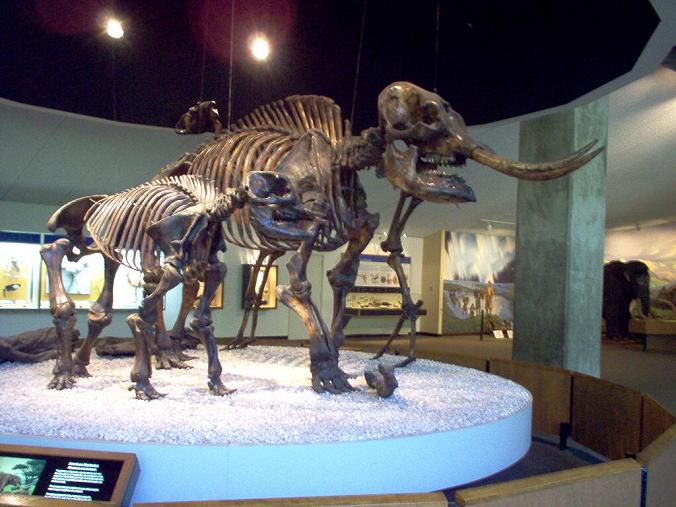
69.28 KB
The mounted skeletons of mastodon and camel ( above ) and giant sloth ( below ) are actually made from the bones of countless animals, since they have become so compacted and jumbled in the cement-like asphalt.
Image Insert:
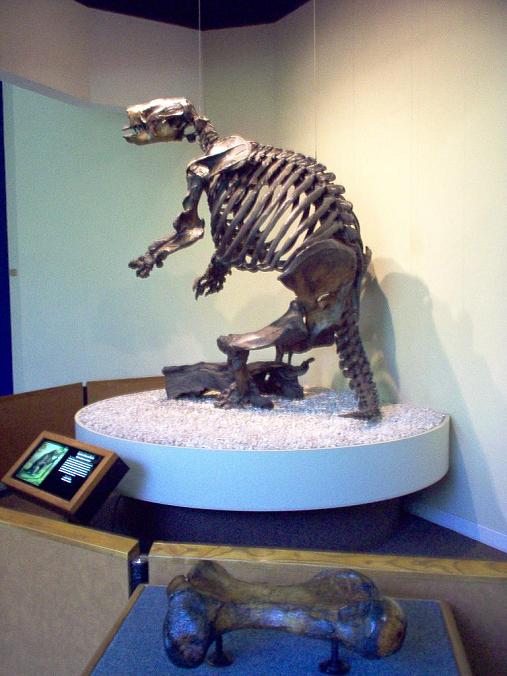
58.91 KB
Image Insert:
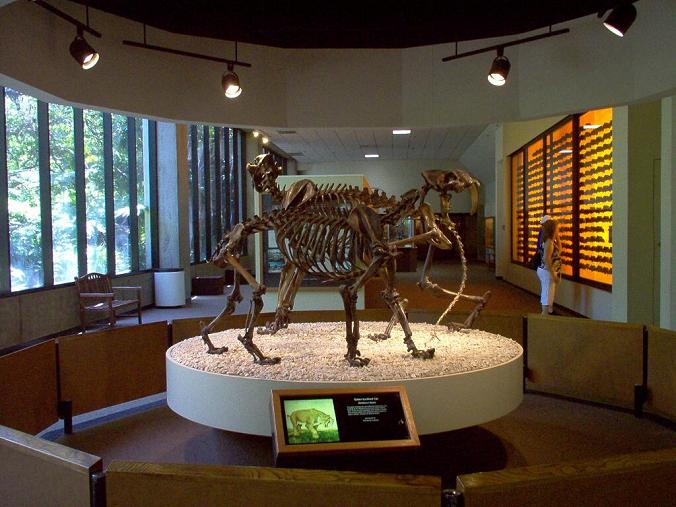
73.66 KB
The undoubted "stars" of the museum, however, are the sabre-toothed cats, seen here; the wall display behind them contains the skulls of 400 Dire Wolves, the most common predator.
Unlike most "fossils" of earlier creatures like dinosaurs, these are actual BONES, preserved by their immersion in the asphalt and are estimated between 10,000 and 38,000 years old. By no means are all displayed: instead, there are skeletons of prominent species, but even these may come from many individual animals because they were so jumbled. Notice in the photo above there is a golden wall case which contains the skulls ( only ) of 400 Dire Wolves, the most frequently-found animal; indeed the ratio is: 1 American Lion - 2 Saber-tooth cats - 4 Dire Wolves. ( Only a single human female has been found, and she is thought to have been a burial; her remains are nowhere to be seen. ) In addition to actual remains there are a couple of "dated" animatronic tableaus, one a 2/3 scale ( WHY - there's plenty of room for a larger one? ) mammoth, the other a sloth attempting vainly to fend off a saber-toothed cat.
Image Insert:
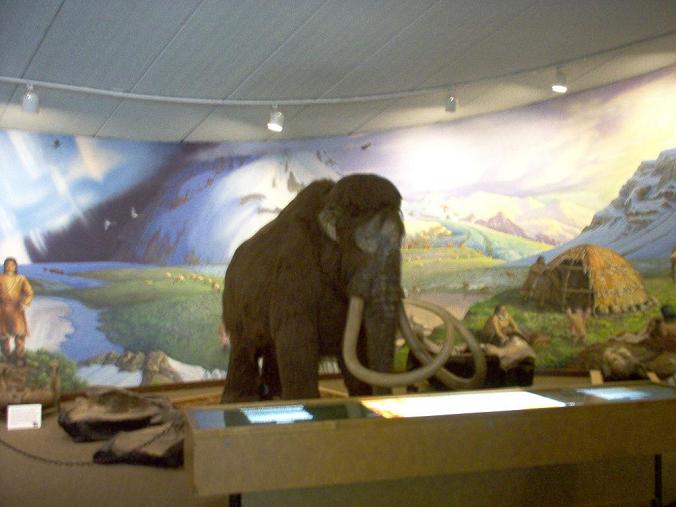
49.91 KB
Image Insert:
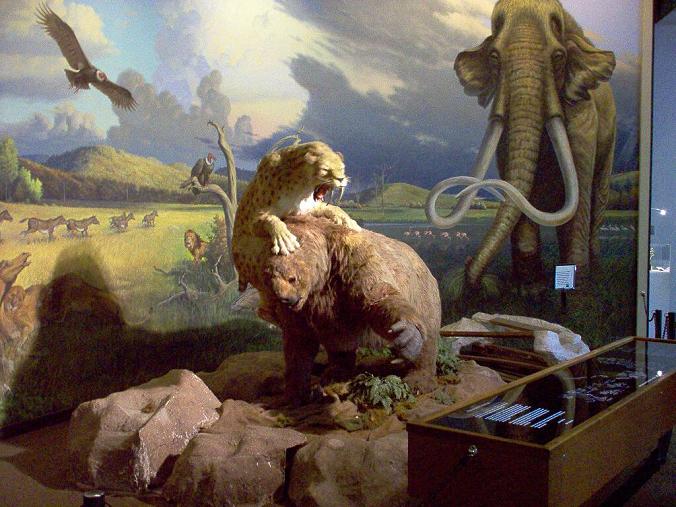
77.54 KB
The Page Museum opened in the 1970's as a place to properly display the contents of the "tar pits"; I easily spent several hours here in the galleries, watching the films, and wandering the grounds where asphalt still pools, a by-product of the oil field beneath Los Angeles that is still being extracted today. Completing the exhibits are an outdoor garden with a pond of HUGE goldfish, and a short series of trails leading to the still-open pools. In front of the museum the largest, now a sort of "lake" covered with an oil slick, contains the life-size diorama of three mastodons, one down fatally in the tar, which did NOT act like quicksand but rather as a sort of giant super-strength "flypaper". Waiting nearby for their turn at discovery are 23 large packing crates of "matrix" unearthed when a nearby parking garage was being built; it's known that they contain at least one 80% complete mastodon!
Image Insert:
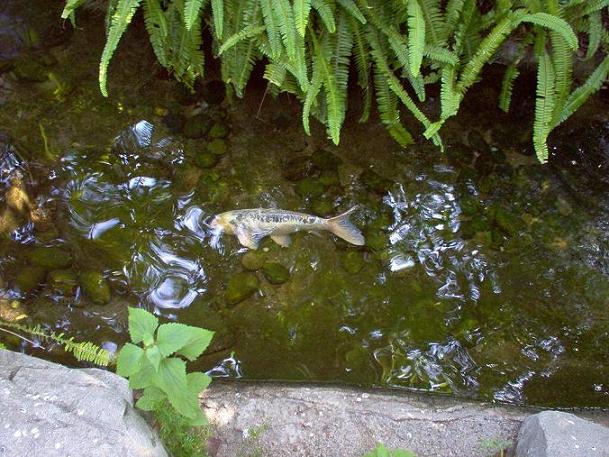
82.36 KB
Image Insert:
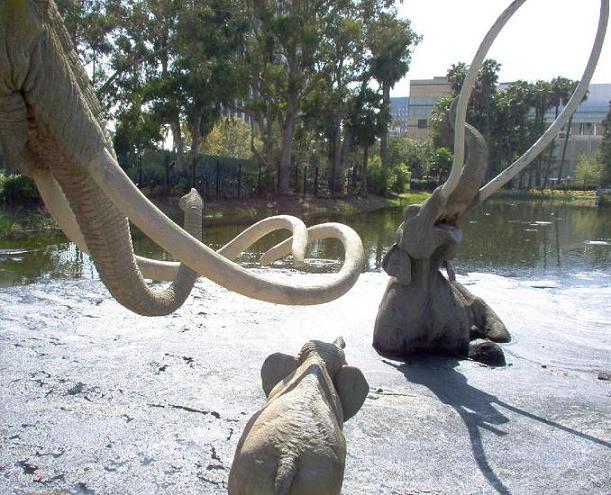
84.09 KB
Image Insert:
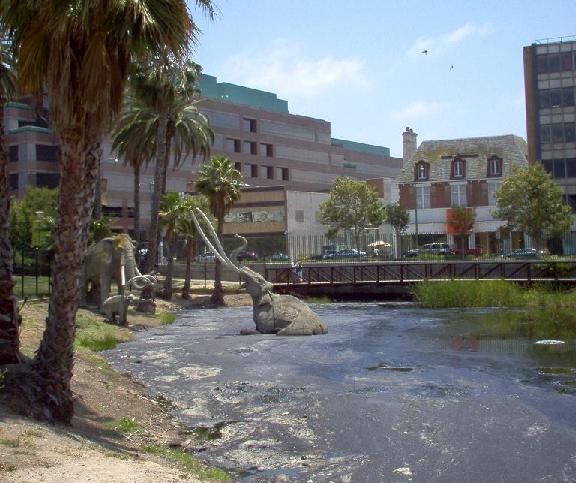
64.95 KB
Incongrous mix of mastodons and motorists on Wilshire Blvd.!
|
|
report to moderator
|
|
|
IWLFNDU
Colonial Settler
  

USA
Bumppo's Patron since [at least]:
May 08 2010
Status: offline
|
 Posted - October 17 2012 : 6:35:45 PM Posted - October 17 2012 : 6:35:45 PM



|
I think this place was once featured on the show Dirty Jobs. Very interesting work they do there, but my, is it messy. Your pictures are once again really great. I don't know what would be a worse way to go out, though--becoming stuck in the goopy tar or attacked by a saber tooth cat! 
|
''Only when the last tree has died, the last river has been poisoned, and the last fish has been caught, will we realize that we cannot eat money.''
~ Cree Proverb |
report to moderator  |
|
|
James N.
Colonial Militia
   

USA

Bumppo's Patron since [at least]:
October 24 2007
Status: offline
|
 Posted - October 17 2012 : 7:34:39 PM Posted - October 17 2012 : 7:34:39 PM




|
quote:
Originally posted by IWLFNDU
I think this place was once featured on the show Dirty Jobs. Very interesting work they do there, but my, is it messy. Your pictures are once again really great. I don't know what would be a worse way to go out, though--becoming stuck in the goopy tar or attacked by a saber tooth cat! 
Thanks, IWLFNDU!
In fact, the palentologists here are STILL removing the tar from specemens in a specially-constructed "fishbowl" laboratory along one side of the museum. It's possible to watch through the glass while they use tweezers to hold items and solvent and scrapers to soften and remove the asphault. I didn't get any photos of the lab, so didn't mention it. My camera had a LOT of trouble trying to focus in here due to the low-level lighting, resulting in far fewer useable shots; some of these are at least a little blurry, but are the best I could get under the circumstances.
Since examples of the large mammals, birds, and amphibians have already long been conserved and displayed, they are now working on smaller things like insects, plants, and even micro-organisms, all of which were likewise trapped in the "tar". As you can see, all the bones remain stained from their long immersion in it; supposedly this is the largest known repository of Ice Age fossils in the world, and many specemens from here have gone to museums around the world. However, wherever they may be now, their origin as having come from La Brea remains obvious due to the permanent brown stain! |
report to moderator  |
|
|
Monadnock Guide
Council of Elders
    
   
USA

Bumppo's Patron since [at least]:
March 14 2005
Status: offline
|
 Posted - October 17 2012 : 10:05:46 PM Posted - October 17 2012 : 10:05:46 PM



|
| Great Pics James, - amazing how life like those animals look. |
you can keep "The Change" |
report to moderator  |
|
|
Fitzhugh Williams
Mohicanland Statesman
    
  

Bumppo's Patron since [at least]:
July 17 2005
Status: offline
|
 Posted - October 18 2012 : 07:45:53 AM Posted - October 18 2012 : 07:45:53 AM



|
Great info. And now another place that I want to see!!!
There is an archaeological dig I go to each year, and it contains a bog. But no one is willing to excavate it because of what they might find. |

"Les deux pieds contre la muraille et la tete sous le robinet" |
report to moderator  |
|
|
Monadnock Guide
Council of Elders
    
   
USA

Bumppo's Patron since [at least]:
March 14 2005
Status: offline
|
 Posted - October 18 2012 : 9:02:49 PM Posted - October 18 2012 : 9:02:49 PM



|
"But no one is willing to excavate it because of what they might find"
.
I would think that would make it more compelling, - to see what "might" be there, ... |
you can keep "The Change" |
report to moderator  |
|
|
Fitzhugh Williams
Mohicanland Statesman
    
  

Bumppo's Patron since [at least]:
July 17 2005
Status: offline
|
 Posted - October 19 2012 : 08:15:10 AM Posted - October 19 2012 : 08:15:10 AM



|
| Not if what is there turns out to be the remains of indigenous peoples. It would shut the site down. |

"Les deux pieds contre la muraille et la tete sous le robinet" |
report to moderator  |
|
|
Wilderness Woman
Watcher of the Wood
    
   

USA

Bumppo's Patron since [at least]:
November 27 2002
Status: offline
Donating Member |
 Posted - October 22 2012 : 12:50:23 PM Posted - October 22 2012 : 12:50:23 PM



|
| I can remember being driven past the tar pits as a child and being enthralled with the "big elephants" struggling for their lives there. |
"It is more deeply stirring to my blood than any imaginings could possibly have been." |
report to moderator  |
|
| |
 Topic Topic  |
|
|
|
| The Mohican Board! [Bumppo's Redux!] |
© 1997-2025 - Mohican Press |
 |
|
| Current Mohicanland page raised in 0.18 seconds |
 |
|

![The Mohican Board! [Bumppo's Redux!] The Mohican Board! [Bumppo's Redux!]](images/wwwboard.gif)



